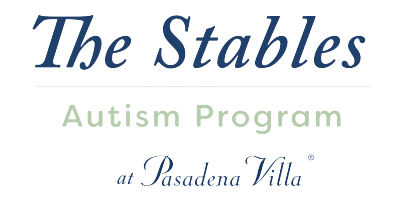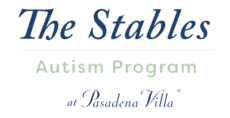Therapeutic Methods and Groups
Home » Our Program » Therapeutic Methods and Groups
The Stables Autism Program Treatment Methods

Behavioral Interventions
We believe in a strength-based approach and empowering our clients to make their own choices in a safe environment. This provides our clients with the opportunity to learn from natural consequences in real time. Parallel to the TEACCH method, when behaviors are observed, the team collaborates to develop individualized behavioral interventions, which are then performed in real time. This allows for the client to develop and practice the skills in diverse situations and environments.
Cognitive Behavioral Therapy (CBT)
Some aspects of ASD or from secondary issues can present obstacles that prevent clients from achieving their goals. CBT helps clients address those challenges so they can make progress toward their goals. Clients with ASD have unique cognitive and behavioral styles, which vary with the severity of their ASD symptoms. In individual therapy, we utilize CBT to meet the strengths and needs of each individual. Clients on the spectrum are generally very concrete thinkers, so the CBT modality is a mix of both cognitive and behavioral strategies designed to help clients adapt healthier perspectives.
Collaborative Problem Solving
Collaborative problem solving is the capacity of an individual to effectively engage in a process whereby two or more individuals attempt to solve a problem by sharing the understanding and effort required to come to a solution by pooling their knowledge, skills, and efforts to reach that solution. Competency is assessed by how well the individual interacts with other individuals during the problem-solving process. This includes achieving a shared understanding of the goals and activities, as well as efforts to pool resources and solve the problem. This framework also identifies four problem solving processes including exploring and understanding, representing and formulating, planning and executing, and monitoring and reflecting.
Dialectical Behavior Therapy (DBT)
DBT for ASD encourages progress in treatment and is largely driven by the client. DBT is geared towards skill building and empowerment and focuses on acceptance and emotional regulation practices. These skills allow clients to develop care plans to use as interventions when their emotions are overwhelming.
DBT also helps clients address social navigation, reducing the vulnerability clients struggle with in social settings. The breakdown on boundary setting is especially helpful, as is the concept of wise mind. Helping our clients improve their emotional regulation and social skills helps to protect them from self-harm and suicidality. DBT focuses on acceptance and mindfulness so clients can build a sense of self that’s integrated and accountable, authenticity and imperfection that work together.
There are four areas of focus in DBT for ASD that are used to help clients establish lasting skills, including:
- Mindfulness : This is the act of noticing and being present and in the moment. This practice encourages us to gain understanding of our emotions and personhood through the purposeful act of awareness without judgement. Through this practice clients learn to identify how their needs are expressed by their bodies.
- Regulating Emotions and Distress Tolerance : This is the practice of recognizing and managing emotions as they come up. Emotions are viewed as important parts of our humanity and our survival. By learning to recognize them, clients can intervene on overwhelming emotions earlier. This practice can help prevent overwhelm and provides tools to avoid self-harm when an individual does become over-stressed. Finding productive outlets for even clients’ toughest emotions is key to their wellbeing.
- Interpersonal Effectiveness : DBT teaches clients about boundaries and how to gauge the intensity of a situation. For example, if a person asks a favor of me, and I don’t want to do it, I can say no. This is a low intensity situation, though it may feel differently. However, when a person ignores my no, they have increased the intensity, so the degree that I assert my no should increase. The ability to set and respect good boundaries is essential to healthy relationship building.
- Crisis Intervention : Part of DBT involves establishing care plans for when emotions become overwhelming. There are group and individual therapy environments geared towards learning and practicing these skills. Support is provided for moments of crisis as well, so that clients don’t have to navigate challenging environments with brand new skills alone.
Experiential Therapy
Experiential therapy is a category, rather than one specific type of therapy. Examples of experiential therapy include recreation therapy, equine therapy, expressive arts therapy, music therapy, wilderness therapy, adventure therapy, and psychodrama. Individuals will experience successes, identify obstacles, develop improved self-esteem, and take greater responsibility for their actions. Clients will have the opportunity to process the activity and receive specific feedback regarding specific actions or behaviors.



Family Systems Approach
Our Family Systems Approach is an integral part of each client’s success in our program. using this approach, therapists arrange twice monthly family sessions, offering daytime, evening, and some weekend hours. Family members can access resources and support through monthly psycho-education groups and training. Additional education and support opportunities include monthly parent training opportunities, an annual family retreat, and networking with the National Autism Center.
Family Therapy
In family therapy, the focus is on helping family members identify ways in which their patterns of thinking, feeling, or behaving is helpful to shift the dynamic of the family in a positive direction. Families in therapy are empowered to help clients continue to manage their ASD symptoms and executive functioning in a way that improves their quality of life. This often involves education on ASD and related symptoms, as well as a collaborative approach to client care.
Individual Therapy
Individual therapy consists of self-exploration and understanding in a safe environment so individuals can better understand and examine various aspects of their life and learn how to build new and healthier relationships.
Life Skills and Independence
Helping a client develop essential life skills to help them become independent is a fundamental part of the program. A crucial part of what separates the Stables Autism Program is its quality trained team who’s rooted in modeling, teaching, training, and nurturing the skills it takes for our clients to reach their full potential. The team works alongside clients on an individual basis to develop the skills it takes to be successful in their day-to-day lives. The skills range from basic daily living skills, such as healthy hygiene habits, table etiquette, cooking and preparing meals, to living independently and maintaining employment.
Mindfulness Activities
Through both yoga and meditation, clients can practice the discipline of self-soothing and centering of thoughts. Mindfulness activities allow inxdividuals to develop the skills needed to overcome cravings and triggers.

Motivational Interviewing
Motivational interviewing is a counseling method that helps people resolve ambivalent feelings and insecurities to find the internal motivation they need to change their behavior. It’s a practical, empathetic, and short-term process that takes into consideration how difficult it is to make life changes.
This intervention helps people become motivated to change the behaviors that are preventing them from making healthier choices. It can also prepare individuals for other types of therapies. Research has shown that this intervention works well with individuals who start off unmotivated or unprepared for change. It’s less useful for those who are already motivated to change. Motivational interviewing is also appropriate for people who experience challenges with emotional management and regulation. They may not be ready to commit to change, but motivational interviewing can help them move through the emotional stages of change necessary to find their motivation.
Nature-Based and Animal-Assisted Therapy (AAT)
A foundational element our program is the interaction with animals and nature, instinctively bringing people together. Animal-assisted therapy (AAT) integrates elements of acceptance and commitment therapy (ACT), cognitive behavioral therapy (CBT), dialectical behavior therapy (DBT), schema therapy and psychodynamic therapy in a unique environment, to help clients improve emotional regulation, self-acceptance, relationship-building skills, and more. All animal activities are conducted by professionals who have incorporated animals as part of their specialty or by another staff member under their supervision.
Social Integration Model™
One of the most powerful ways to predict psychological well-being in adults is to look at how socially connected they are to other people, which is one of the core issues affecting individuals with ASD who often experience social isolation. Remaining socially integrated is, in our view, a key component of successful living.
hrough modeling, active training, repetition, and variable reinforcement schedules, along with cognitive processing and psychiatric interventions, we ensure that each of our clients meets their maximum social integration potential. Using targeted individual coaching, we help our clients develop improve their social skills. With the repetition of improved social skills comes decreased social anxiety and increased success at the activities. With increased success comes participation in family life and integration into society, culminating in better social functioning, and perhaps more importantly, an improved sense of dignity and enjoyment of life.
Autism Care and Support utilizes our unique adaptation of the Social Integration Model™ to help normalize the behaviors of our clients. The philosophical goal is to assist each person in achieving maximum social functioning so that they socially integrate into their families and society at large and can enjoy those benefits of ‘belonging and participating’.
Vocational Skill Development and Employment
Expanding social skills beyond college and incorporating job-related activities into healthy relationship development is a unique and creative aspect of our skill development programming. A crucial part of developing a successful program of this kind is rooted in collaborating with community members who can help with jobs or volunteer opportunities as clients progress through the program.

The Stables Autism Program Treatment Groups

Activities Group
Through this group, clients can participate in a wide array of indoor and outdoor activities each day, including hiking, exercising, mountain biking, horseback riding, volleyball, arts and crafts, music, and indoor games. Participating in these activities requires clients to engage in social interaction, communication, and planning skills, and provides real-time interaction with peers.
Anger and Behavioral Control (ABC) Group
This group teaches effective ways to handle anger, cope with stress, and problem-solve effectively.
Anger Management Group
This group addresses problems caused by the expression of negative emotions as clients learn anger management skills, stress reduction techniques, and how to express emotions positively.
Community Meeting Group
The Community Meeting Group is a structured, task-oriented group which allows our staff to monitor the current milieu of the program. This group is a forum during which community-wide issued are addressed and changes to schedules and/or routines are announced. Clients can also resolve interpersonal issues which may result from participation in the program.



Cooking Group
In a motivating and supportive environment, clients learn valuable skills such as the latest nutrition information and how to create a grocery list using a budget. Each client also experiences and participates in meal planning and food preparation. Once a week, under staff supervision, each client can gain confidence by preparing an evening meal for their peers to enjoy.
Co-Occurring Group
Individuals suffering from a substance abuse problem and a mental health disorder will learn how to recognize the two distinct conditions, how they interact with each other, and to develop an understanding of the role medications have in their recovery.
Good Over All Living Skills (GOALS) Group
By actively participating in the process, individuals learn to improve communication skills, decision-making skills, and quality of living, as well as experience the value of goal setting and goal-related success.
Healing Through Feeling Group
This group exposes clients to coping skills, anger management strategies, social skills and feeling identification, allowing them to practice new skills through games and role play.

Living Well Group
Clients with stress, anxiety, depression, and co-occurring disorders benefit from this group that provides a setting in which relaxation techniques are demonstrated and experienced.
Medication Support Group
This group focuses on the risks of overusing prescription drugs by teaching clients about the most abused prescription drugs and their effects, and helping clients understand the interaction of prescription drugs with other substances. Unintentional abuse and deliberate abuse are discussed and how dependency can develop during a standard course of medical treatment.
Relapse Prevention Group
This group provides a safe and supportive learning environment through specialized tracks for individuals recovering from eating disorders, substance use disorders, and or co-occurring disorders. Many people find it challenging to stay on the right path and exert self-control when it comes to old, unhealthy habits. Relapse prevention groups exist to help individuals in recovery stay clean, sober, and focused so they avoid relapsing. The activities facilitated by our relapse prevention group help clients practice making positive choices in their lives.
Self, Responsibility, and Assertiveness Group
Self-assertiveness is having or showing the confidence and courage in stating your views, expressing your feelings, asking for what you want and enjoying your rights – all done with integrity, honesty, directness, and respect for others. This group process helps individuals to learn how to maintain self-respect while communicating personal views, expressing awkward or difficult feelings, and asking for what they want while being an open and willing participant in the process.



 Call
Call